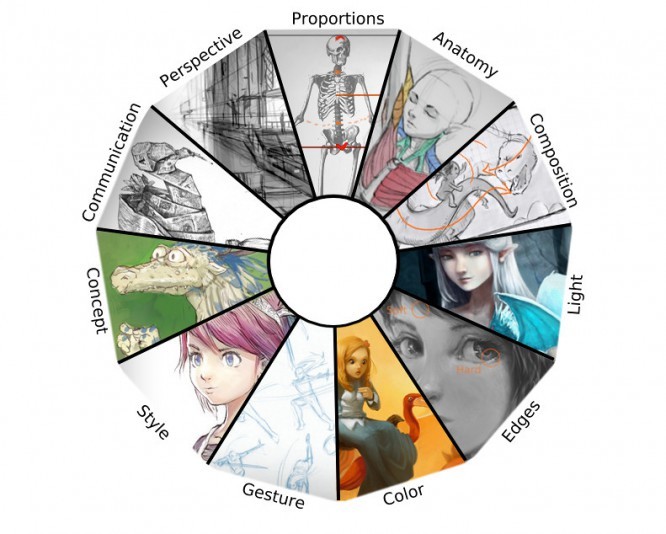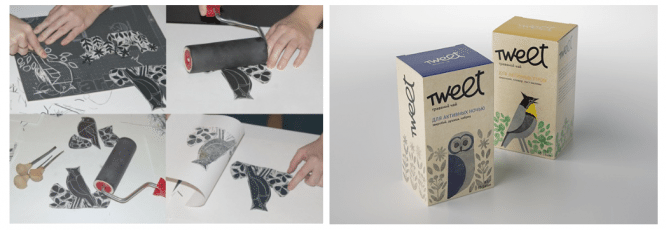David Revoie: 11 Essential Illustrator Skills
David Revoie: 11 Essential Illustrator Skills
David Revoie is an excellent free software artist, a regular member of the Krita Foundation and Blender Institute communities, concept artist for the Gooseberry Open Movie Project, Mango Open Movie Project (Tears of Steel) and the Durian Open Movie Project (Sintel).
In his article, he shares with novice artists a list of knowledge that must be acquired in order for the work to turn out to be realistic. He draws attention to the fact that for drawing “in digital” one should acquire the same skills as in the traditional technique. So, let’s join his experience.

“It is difficult to choose what to study for those who are going to take up painting … I receive many letters on this topic; beginners usually feel lost, lost in the midst of it all. Therefore, I decided to make a kind of table of contents – a list of what you need to learn and what you need to practice in order to create quality work and learn how to draw better. Each paragraph is supplied with my simple comments answering the questions “what”, “why”, “how”.
This will make it easier to find the material you want using your favorite search engine. Also, this material can be useful for those who want to improve the quality of their work. I will use these starting points in my exercises and when looking for errors in my work.
If you’re just starting out, here’s my advice: be erudite, learn the basics, and focus on individual elements one at a time.
1. Perspective
What is it: The art of rendering three-dimensional space on a flat surface.
What is the purpose: Do not draw flat, depict depth on 2D paper.
What you need to find out about this: The perspective grid, how simple shapes (cubes, balls, etc. …) behave in perspective and how to keep the proportions.
 Work based on two vanishing points (green and red)
Work based on two vanishing points (green and red)
2. Proportions
What is it: The ratio of the sizes of all objects in your drawing.
What is the purpose: Draw recognizable objects by stereotyping proportions.
What you need to find out about this: Learn to memorize proportions, find a way to easily memorize the ratios of parts of an object, compile a “dictionary” of proportions.
 Orange lines show the main proportions and ratios in the figure (left) and sketch (right)
Orange lines show the main proportions and ratios in the figure (left) and sketch (right)
3. Anatomy
What is it: Study of the structure.
What is the purpose: Draw objects realistically (people, animals, plants, equipment, etc. …).
What you need to find out about this: Joints, bones, muscles, how they work, how they behave, how parts are connected, etc.
 Hand drawing exercise (left), skeleton drawing exercise (center), muscle study (right)
Hand drawing exercise (left), skeleton drawing exercise (center), muscle study (right)
4. Composition
What is it: Location and presentation of visual elements of the picture.
What is the purpose: To convey feelings and emotions to the viewer with the help of a drawing.
What you need to find out about this: Deal with a set of angles and understand how they affect the perception and “readability” of the work.
 Various sketches before starting work; song search
Various sketches before starting work; song search
5. Lighting
What is it: Light and shadow rendered in color.
What is the purpose: Create the illusion of light, display correct shadows, achieve volume and convey mood.
What you need to find out about this: Color values, shadow casting, influence of surface materials, light reflection, light characteristics (refraction, scattering materials, etc. …).
 Left: the light shows the difference in material, right: the use of light to show the second character (cast shadow)
Left: the light shows the difference in material, right: the use of light to show the second character (cast shadow)
6. Edges
What is it: A way to highlight the silhouettes of objects in your drawing.
What is the purpose: Make the work easier to read, separate objects and background, enhance the effect of depth.
What you need to find out about this: Edge style (hard / soft / lost) in drawing, line styles (weight, speed, softness) for paths.
 Left and center: edges in the picture, right: outline thickness
Left and center: edges in the picture, right: outline thickness
7. Colors
What is it: The art of choosing the right shades (midtones, shadows, highlights).
What is the purpose: Add more movement, mood and emotion to your work.
What you need to find out about this: Color systems (monochromatic, complementary, etc.), peculiarities of the influence of colors on mood, stereotypes.
 Top left: 3 color circles representing the palettes for this work; three complementary colors
Top left: 3 color circles representing the palettes for this work; three complementary colors
8. Poses
What is it: The art of capturing active movement on a static sheet.
What is the purpose: Add life, energy, movement and show dynamics.
What you need to find out about this: Emotional strokes, sketches, quick drawings, the study of everything moving, frequent “warm-up” exercises.
 Left: zoo penguin poses, center: learning poses while moving, right: warm-up figure sketches
Left: zoo penguin poses, center: learning poses while moving, right: warm-up figure sketches
9. Style
What is it: Aesthetics, sense of style. Often depends on fundamental standards (ethical, historical, social, symbolic), art of cultural groups, art market.
What is the purpose: Pave the way for the work to the audience.
What you need to find out about this: Your own taste, culture, creative team as an audience and creators at the same time.
 Left: classic black and white portrait, center: highly stylized (and weird) character and painting style, right: my comic style
Left: classic black and white portrait, center: highly stylized (and weird) character and painting style, right: my comic style
10. Idea
What is it: Drawing abstract concepts, idea associations, inventing and proposing a new design. It’s mostly a development process.
What is the purpose: Suggest new images of objects, characters and creatures to entertain or inform the public.
What you need to find out about this: How things work, how to create new things, associations of ideas, funny situations, the creative process.
 A new type of vehicle (left), a new type of dragon (center) and a medieval house that no one has seen before (right)
A new type of vehicle (left), a new type of dragon (center) and a medieval house that no one has seen before (right)
11. Communication
What is it: An image can convey a large amount of complex information quickly. The proverb “A picture is worth a thousand words” explains it well.
What is the purpose: The artist can communicate (internationally or not) with the audience.
What you need to find out about this: Reading images (decoding sent messages, non-verbal signs), conveying meaning, history, information.
 The drawing of the sheet does not convey much information (left), but a complex of details and facial expressions can already tell a story (center). A symbol such as a stamp from newspapers (right) can make you think deeper about the problem of unethical journalism.
The drawing of the sheet does not convey much information (left), but a complex of details and facial expressions can already tell a story (center). A symbol such as a stamp from newspapers (right) can make you think deeper about the problem of unethical journalism.
Conclusion: a meaningful illusion
If you can correctly combine all of the above, you will achieve a sense of volume, depth, texture, light, movement and life on a static surface. This will immerse your viewers in your world and you can easily convey your ideas, messages or story to them. And finally, as I see the result: the art of creating meaningful illusions. This whole palette of skills will serve your intellectual (memory, control, determination) as well as emotional development (feelings, emotions, subconsciousness).
This is a complex exercise that requires knowledge, observation, imagination, but above all you need to PRACTICE, PRACTICE and PRACTICE. Drawing skill is like a muscle (and you certainly won’t get stronger by reading a book on weight lifting or watching a video), so good luck with drawing and painting, build your own unique experience. “
Source: habrahabr
…


